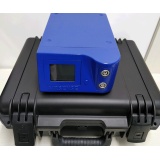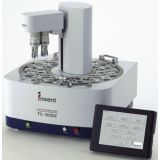搜全站
搜展位
解决方案
你对烟熏液了解多少?
应用领域
其他检测样品
其他检测项目
烟熏液德国AIRSENSE公司的PEN3电子鼻采集烟熏液样品的气味信息,经过电子鼻自带的分析软件进行分析,本实验提取10个传感器的特征值,然后采用主成分分析法(PCA),线性判别法(LDA)和传感器区别贡献率分析法(Loadings)作为主要区别分析方法。下图是烟熏液的电子鼻LDA线性判别图。在 LDA 分析中7个烟熏液之间的差异非常明显,得到了很好的区分。

共1台
电子鼻_EN_及其在多领域中的应用
应用领域
其他检测样品
其他检测项目
医学、 农业、 食品、 环境等领域的应用摘要:电子鼻传感器( EN)技术的的发展提高了气体和离子检测的分辨能力和检测精度.本文介绍了电子鼻的基本原理和组成.探讨了电子鼻在医学、 农业、 食品、 环境保护、 工业和等方面的应用

共1台
电子鼻及其在各领域的最新研究进展
应用领域
其他检测样品
其他检测项目
各领域的最新研究进展摘要: 电子鼻是由多个性能彼此重叠的气敏传感器和适当的模式识别算法组成的具有识别单一和复杂气体能力的装置。本文介绍了电子鼻的基本原理及主要组成部分;综述了电子鼻近年来在食品、环境、农业、医学、公共安全等领域的研究进展; 后展望了其未来发展趋势。

共1台
电子鼻技术的发展及展望
应用领域
其他检测样品
其他检测项目
发展及展望 摘 要: 文章介绍了电子鼻的定义、 系统组成和工作原理,重点阐述了气敏传感器、 信号与处理、模式识别等关键技术的发展现状;详细介绍了它在食品工业、 精细化工、 医疗诊断、 环境监测、 公安与海关、 火星生命探索等方面的应用实例; 后展望了其未来发展趋势。

共1台
电子鼻用于脂质高分子膜甜味传感器的响应物质
应用领域
其他检测样品
其他检测项目
A sweetness sensor with lipid/polymer membranes has been developed for evaluatingthe sweetness of sugars and sugar alcohols. Among the constituents of lipid/polymermembranes, gallic acid has been used as the main substance involved in sucrose responsein our group. In this study, as a step toward understanding the response mechanism ofthe sweetness sensor, functional groups of gallic acid, namely, carboxyl and hydroxylgroups, were focused on. Theresultsdemonstrated that the carboxyl group is essentialfor the sweetness sensor, whereas the hydroxyl group is not always necessary for thesucrose response. It was also revealed that the phosphate group may be a substitutefor the carboxyl group. Then, for one of the sensors with the highest response to a 300mM sucrose solution, named the sweetness sensor GL1, the basic characteristics suchas selectivity and correlation with sweetness were investigated. The behavior of GL1sensor outputs was relatively similar to the sweetness perception in humans.

共2台





